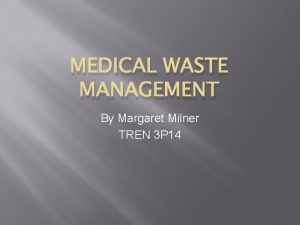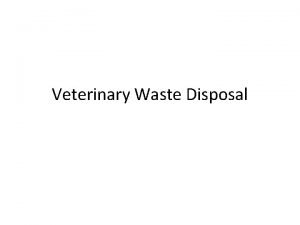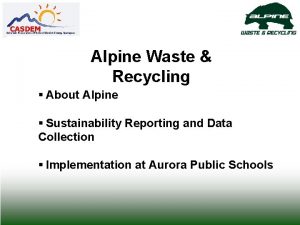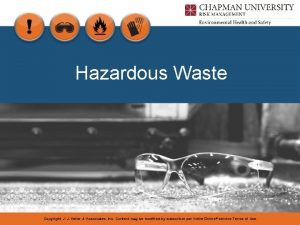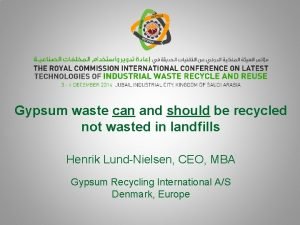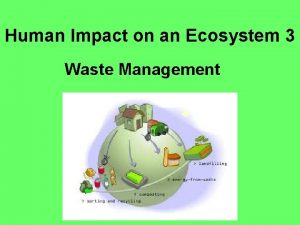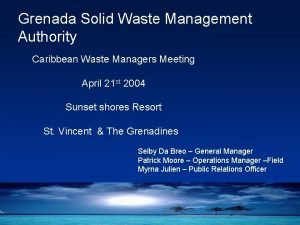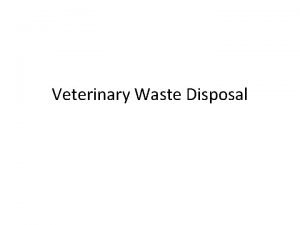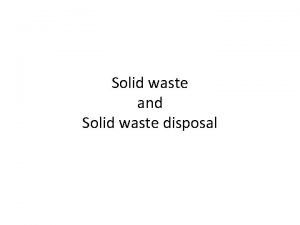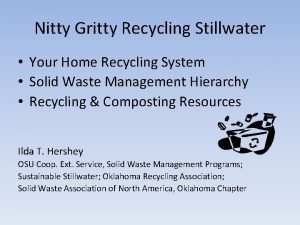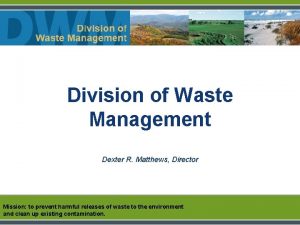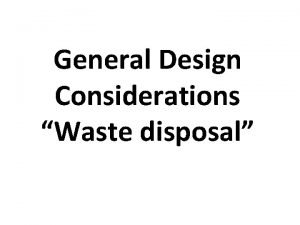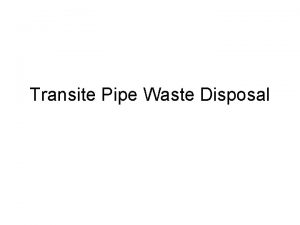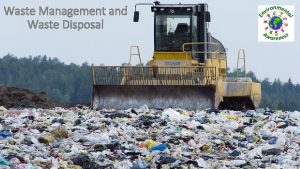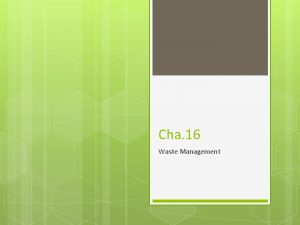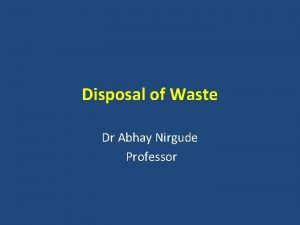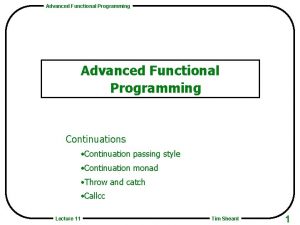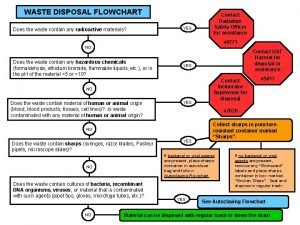CONTINUATION OF REFUSE DISPOSAL OR DISPOSAL OF WASTE


















- Slides: 18

CONTINUATION OF REFUSE DISPOSAL OR DISPOSAL OF WASTE

REFUSE DISPOSAL • The term ‘ solid waste ‘ includes garbage (food wastes) , rubbish (paper, plastic wood, throw away containers, glass), other products (bricks, pipes) , sewage treatment residue (sludge &solids from the screening of domestic sewage) , dead animals, manure & other discarded materials. • The nature, composition & volume of refuse produced vary between different countries, different seasons, different life styles & life activities of population.

• Refuse is discarded waste matter. (The house hold waste is called ‘refuse’). • Refuse from houses, streets, sweeping, commercial, industrial & agriculture operations is called ‘solid refuse’. • Refuse is also called solid waste.

HEALTH HAZARDS OF REFUSE The accumulation of refuse on man’s environment is dangerous to health, because : • It decomposes & increases fly breeding. • It attracts rats & vermin ( Parasitic insects or worms). • Water & soil may get polluted due to refuse.

• The pathogenic organisms which are present in the refuse may be conveyed back to man’s food through flies & dust. • Heaps ( large amount) of refuse present an unsightly appearance, & are a nuisance ( causing inconvenience). So refuse, should be promptly collected, removed & disposed off in a sanitary manner.

COMPOSITION OF REFUSE • Decomposable – this generally includes organic material of human or animal origin excluding excreta. It includes discarded food items, vegetables peelings, dung of cattle, excreta of dogs, dropping of birds & bodies of dead animals, etc. • No decomposable component – it includes combustible items like leaves, paper, packing materials, rags etc. & non combustible items like pottery pieces, tins, bottles, etc. The non decomposable refuse items have a tendency to get scattered.

SOURCES OF REFUSE • Domestic refuse – it includes kitchen garbage arising during preparation, distribution & and consumption of food items, it comprises vegetable peelings, discarded fruits & various food remnants. • Street refuse – includes decomposable & non decomposable, wastes items issuing from markets, hostels, offices, etc. It also includes street sweeping consisting of rubbish & organic waste matter.

• Industrial refuse – includes metal shavings, metal cuttings, metal scrappings, dust & various type of discarded items. • Constructional refuse – includes sand, stone pieces, bricks, wood shaving & variety of discarded items. • Hospital refuses – contains both organic & inorganic waste items such as laboratory waste, dressings, human tissues, needles, & syringes.

METHODS OF WASTE DISPOSAL Various methods of waste disposal can be choosen depending on the quantity & type of refuse in the urban & rural areas. • Small scale methods • Large scale methods

• Small scale methods Waste collected from home, rural area & camps can be disposed in the following manner. * burning – refuse is collected in an open place & burned everyday. * Feeding the animals – uncontaminated food stuff like left over food, fruits, vegetables, leavings can be fed to animals.

* Burial – a burial trench (pit) that is 1. 5 mtrs & 2 mtrs deep in dug. Every day refuse is put into it &then covered with 20 -30 cms thick layer of soil. When they depth of trench is reduced to only 4 cms from ground level, then it is covered compactly &another trench is dug up for use. After 4 -6 mnths the first trench can be dug open to obtain manure (fertilizer).

• Large scale methods * incineration - this is the best method of waste disposal. Tin, glass, sand etc should be removed from the refuse before burning it. Incinerators are used to burn the refuse before burning it. Presently, under environment management hospitals have been directed to use incinerators to dispose off biomedical waste. Incinerators can burn 25 -450 kg of refuse every day.

• Dumping – according to this method, waste is dumped into low lying areas so as the level of ground can be lifted & brought to the same level of surrounding area. Here refuse decomposes into manure but this ground should be far away from residential areas. • Controlled tipping – this is healthy technique, but sufficient land should be available for it. A trench 23 metres deep, 12 meters broad & of suitable length.

• Composting – It is a process Of nature whereby the organic matter is broken down under bacterial action resulting in the formation of a material. This method is suitable for small towns & for rural areas. • Methods of composting - Bangalore method - mechanical composting.

• Bangalore method – This method was introduced by environment & sanitation committee of Bangalore so. It is called Bangalore method. In this method a trench will be made 90 cmdeep, 1. 5 to 2. 5 m broad & 10 m long in that excreta &refuse can be disposed. - In that trench the first layer should be waste in 15 cm thickness & excreta 5 cm thickness. - Like this alternatively filled.

- The top most layers should be refuse. - It will take 7 days for decomposition the aerobic & anaerobic bacteria digest the waste. - It is also called hot fermentation method. - This must be done away the city almost 800 m. • Mechanical composting. - In this method a mechanical device will be used to grind items like stick, clay, plastic, glass, etc. After grinding same method will be followed. - This method is followed in most of the cities.

QUESTION BLOG� • Enlist the health hazards Of refuse? • What are the sources of refuse? • explain the methods of waste disposal?

 Define solid waste management
Define solid waste management Milner waste management
Milner waste management Veterinary waste management
Veterinary waste management Alpine waste
Alpine waste Waste disposal lyndon
Waste disposal lyndon Hazardous waste transportation
Hazardous waste transportation Disposal of gypsum waste
Disposal of gypsum waste Waste companies lindsay
Waste companies lindsay Grenada trash pickup
Grenada trash pickup Medico waste disposal
Medico waste disposal 3 waste management
3 waste management Grenada trash haulers
Grenada trash haulers Grenada trash pickup
Grenada trash pickup Disposing of veterinary clinical waste
Disposing of veterinary clinical waste Ramp method of waste disposal
Ramp method of waste disposal Stillwater ok waste disposal
Stillwater ok waste disposal Screw feed technology of waste management
Screw feed technology of waste management Matthews waste disposal
Matthews waste disposal Arnprior waste disposal site
Arnprior waste disposal site

